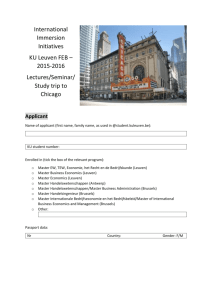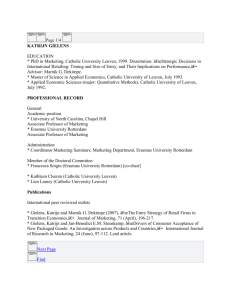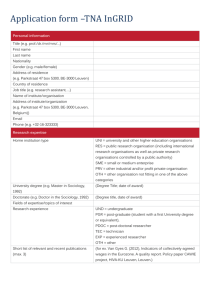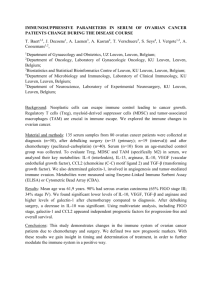Student Network Design Projects Using OPNET
advertisement
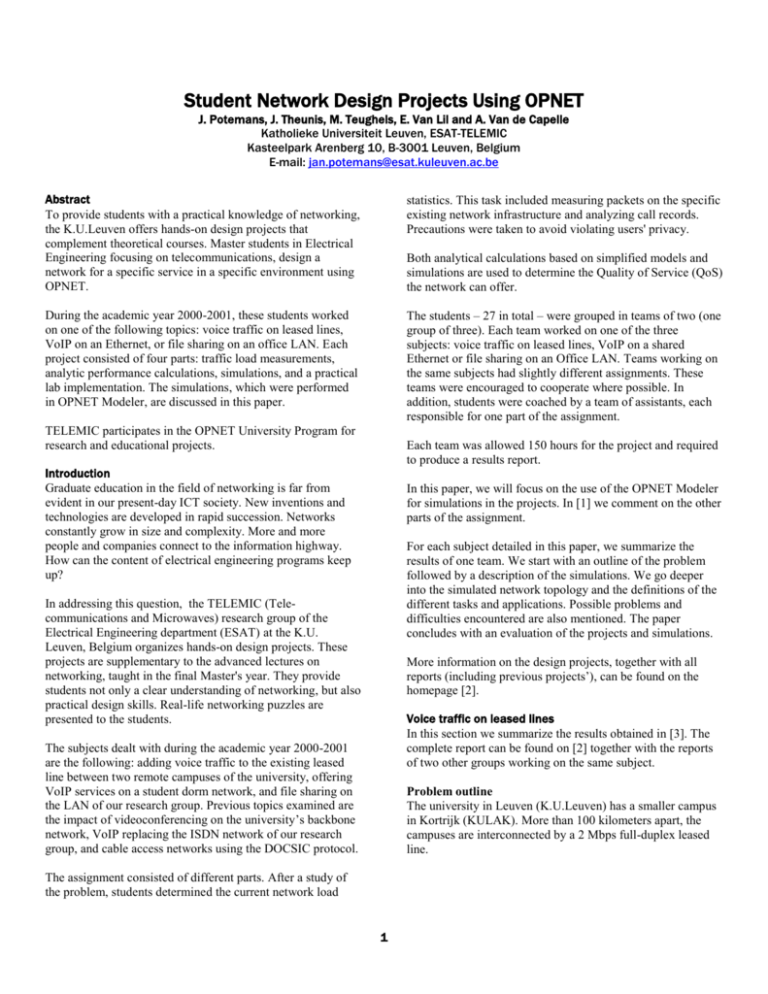
Student Network Design Projects Using OPNET J. Potemans, J. Theunis, M. Teughels, E. Van Lil and A. Van de Capelle Katholieke Universiteit Leuven, ESAT-TELEMIC Kasteelpark Arenberg 10, B-3001 Leuven, Belgium E-mail: jan.potemans@esat.kuleuven.ac.be Abstract To provide students with a practical knowledge of networking, the K.U.Leuven offers hands-on design projects that complement theoretical courses. Master students in Electrical Engineering focusing on telecommunications, design a network for a specific service in a specific environment using OPNET. statistics. This task included measuring packets on the specific existing network infrastructure and analyzing call records. Precautions were taken to avoid violating users' privacy. During the academic year 2000-2001, these students worked on one of the following topics: voice traffic on leased lines, VoIP on an Ethernet, or file sharing on an office LAN. Each project consisted of four parts: traffic load measurements, analytic performance calculations, simulations, and a practical lab implementation. The simulations, which were performed in OPNET Modeler, are discussed in this paper. The students – 27 in total – were grouped in teams of two (one group of three). Each team worked on one of the three subjects: voice traffic on leased lines, VoIP on a shared Ethernet or file sharing on an Office LAN. Teams working on the same subjects had slightly different assignments. These teams were encouraged to cooperate where possible. In addition, students were coached by a team of assistants, each responsible for one part of the assignment. Both analytical calculations based on simplified models and simulations are used to determine the Quality of Service (QoS) the network can offer. TELEMIC participates in the OPNET University Program for research and educational projects. Each team was allowed 150 hours for the project and required to produce a results report. Introduction Graduate education in the field of networking is far from evident in our present-day ICT society. New inventions and technologies are developed in rapid succession. Networks constantly grow in size and complexity. More and more people and companies connect to the information highway. How can the content of electrical engineering programs keep up? In this paper, we will focus on the use of the OPNET Modeler for simulations in the projects. In [1] we comment on the other parts of the assignment. For each subject detailed in this paper, we summarize the results of one team. We start with an outline of the problem followed by a description of the simulations. We go deeper into the simulated network topology and the definitions of the different tasks and applications. Possible problems and difficulties encountered are also mentioned. The paper concludes with an evaluation of the projects and simulations. In addressing this question, the TELEMIC (Telecommunications and Microwaves) research group of the Electrical Engineering department (ESAT) at the K.U. Leuven, Belgium organizes hands-on design projects. These projects are supplementary to the advanced lectures on networking, taught in the final Master's year. They provide students not only a clear understanding of networking, but also practical design skills. Real-life networking puzzles are presented to the students. More information on the design projects, together with all reports (including previous projects’), can be found on the homepage [2]. Voice traffic on leased lines In this section we summarize the results obtained in [3]. The complete report can be found on [2] together with the reports of two other groups working on the same subject. The subjects dealt with during the academic year 2000-2001 are the following: adding voice traffic to the existing leased line between two remote campuses of the university, offering VoIP services on a student dorm network, and file sharing on the LAN of our research group. Previous topics examined are the impact of videoconferencing on the university’s backbone network, VoIP replacing the ISDN network of our research group, and cable access networks using the DOCSIC protocol. Problem outline The university in Leuven (K.U.Leuven) has a smaller campus in Kortrijk (KULAK). More than 100 kilometers apart, the campuses are interconnected by a 2 Mbps full-duplex leased line. The assignment consisted of different parts. After a study of the problem, students determined the current network load 1 Up to the time of the networking puzzle that this paper documents, this 2 Mbps line was used only to transmit data traffic. the calls (221.8 s) during busy hours. Both measurements were used as mean values of exponential distributions. In order to add voice traffic to the network, an Ethernet workstation was connected to each router. For simplicity, each POP was studied without modeling the voice gateway and PABX. At the beginning of the project, Belgium still had several phone zones. Phone calls to the same or a neighboring zone were charged at local rate, while long distance calls were charged a substantially higher rate. Transmitted via the leased line, the university’s calls between its two campuses, in Leuven and in Kortrijk, would be for free. Analogously, calls from the Kortrijk campus to the Leuven area would be “local calls” for billing purposes. In addition, students examined where to add other POPs (Points of Presence) to cover the complete Flemish part of Belgium and to convert it into one big phone zone. This way, all calls from university to a destination in this big zone, would be charged at local rate. Of course, any possible cost savings would have to be weighed against new costs in hardware, leased lines, etc. Two voice profiles were defined: one for voice calls originating from Leuven and another one for voice calls originating from Kortrijk. The weighing table in Figure 2 shows the destination preference for the voice profile in Leuven. Solution It was resolved that to cover the complete Flemish part of Belgium, two extra POPs would be necessary: one in Gent and one in Tongeren. To minimize the leasing cost (distance), Gent was connected to Kortrijk, while Tongeren was connected to Leuven. The resulting topology is mapped in Figure 1. Figure 2: Weights for the Leuven voice profile The predefined Voice over IP application model was used to generate voice traffic. Figure 3 and 4 show how the measured call duration and the interarrival time could be configured for use in simulations. Figure 1: Simulation topology Figure 3: Configuration of the call duration A router was placed in each POP. The effective routing capacity of each router was adjusted in the attributes menu (100.000 p/s in Leuven, 40.000 in Kortrijk, 5000 p/s in Gent and Tongeren). Serial lines were linked to the routers: 2 Mbps between Leuven and Kortrijk, 1 Mbps between Kortrijk and Gent, and, finally, 128 Kbps between Leuven and Tongeren. However, the network infrastructure still had to carry normal data traffic, just as it always had. Not only the load of the line but also the total load of the routers had to be figured in, for determining the network’s QoS. Students used SNMP requests to measure the number of packets and bytes transmitted through each router port. It was also decided as a condition, that all traffic has to be transmitted in packets over this network infrastructure. The measured data traffic on the leased line between Leuven and Kortrijk was simulated by an interaction between an Ethernet workstation in Leuven (kuldata2) and an Ethernet server in Kortrijk (server_kulak_2). Each time the server received 5 request packets, it answered with 2 response packets. This ratio represented the difference in amount of traffic in both directions. To obtain a realistic load, students analyzed call traces from the university and parameterized necessary statistics: the interarrival time between the calls (6.41 s) and the length of 2 To keep within the scope of this paper, we will focus on the link between Leuven and Kortrijk. The complete results are available in [3]. Figure 7 and 8 show the traffic load (in packets/s and bits/s) and the delay in both directions, respectively. Figure 4: Configuration of the interarrival time The average packet size was calculated from the measurements: 444 bytes going from Leuven to Kortrijk and 194 bytes in the other direction. The students assumed an exponential distribution for both packet sizes. The average inter-request time was 0.1 s, and assumed to be exponentially distributed. Figure 5 and 6 show the configuration of the client and the server, respectively. Figure 7: Traffic load between Leuven and Kortrijk Figure 5: Configuration of the client Figure 6: Configuration of the server To simulate the other load of the routers in Leuven and Kortrijk, a workstation-server pair was added both in Leuven and Kortrijk. The total number of packets (requests and responses) equaled the total load of the router measured with SNMP, minus the number of packets that were transmitted on the 2 Mbps leased line. Figure 8: Delay between Leuven and Kortrijk 3 The delay values indicated an acceptable level of voice quality. The network was not overloaded by the addition of voice traffic. One PC represented the internal data traffic, another the external data traffic, while the third was used for voice traffic. The simulated topology is depicted in Figure 10. VoIP on a shared Ethernet This section offers an overview of the results obtained in [4]. The complete report can be found on [2], together with the reports of three other groups working on the same subject. Problem outline Students living in a university dorm can access ‘Kotnet’ (the student network infrastructure) from their room via a shared Ethernet connection. On each floor of the dorm there is one public telephone, which students can use to dial or receive calls. During busy hours, this single phone cannot service demand adequately for 11 students per floor. Adding more telephone lines is an expensive operation. Therefore, the university wanted to know how it could use the computer network to offer VoIP services to each student room. Figure 10: Simplified topology for simulations For each traffic stream, a different task was defined. Because of memory limitations, no distinction in packet size classes could be made for a specific stream. Table 1 provides an overview of the different tasks. For management and security reasons, the university wanted to place the necessary servers and gateway in a central place called ‘Ludit’. In this project, students tried to determine whether these VoIP services could be offered to the students of the ‘Blok5’ dorm. Figure 9 shows the path the voice traffic of Blok5 had to follow to reach the gateway at Ludit. source 1 blok5 2 blok5bar 3 rest kotnet 4 blok5back 5 kotnetback destination server kulnet barbara server kulnet blok5 rest kotnet interreq. time (s) 5.5e-3 1.07 e-3 2.38e-4 5.5e-3 1.35e-4 size (bytes) 1116 1307 1116 1116 1116 Table 1: Task definitions Two profiles were defined: one for data traffic and one for voice traffic. The voice application settings are listed in table 2. Codec Frames per packet Frame size Lookahead size DSP processing Coding rate Figure 9: From Blok5 to the voice gateway G 723.1 4 30 ms 7 ms 1 6.3 Kbps Table 2: Voice-application settings Solution Because the delays from the different switches proved to be negligible compared to the router-based delays, all switches were omitted from the simulations. Also the gateway could be disregarded because it added a constant delay. Initially, to baseline the current situation, students ran simulations without voice. The traffic sent and received by the blok5bar PC is plotted in Figure 11. At the application layer 930 p/s were sent to barbara while only 182 p/s were sent at the IP layer. This discrepancy was caused by a saturated Ethernet: The application sent more packets than the network could transport. In our model, about 50 PCs were connected to the hub in Blok5. To reduce simulation time, only 3 PCs and a server were used to generate the complete traffic load. 4 Blok5bar was not configured to receive traffic. The values in Figure 11 result from TCP acknowledgements, which were generated each time a packet was transmitted successfully. Students performed simulations in two other cases: one with a single active voice call and one with three simultaneous calls. Figure 13 gives the end-to-end delay and the variation on this delay for one active call. The Ethernet collision count and the utilization in this case can be found in Figure 14. Figure 11: Traffic sent and received by blok5bar Figure 13: Voice end-to-end delay and variation on this delay for one active call Figure 12 shows Ethernet delay, collision count, and utilization, respectively. The Ethernet is overloaded. Therefore, it was concluded that adding voice traffic to the existing infrastructure was not feasible during peak traffic loads. Figure 14: Ethernet performance parameters one active call for The voice application end-to-end delay does not include the delay of the gateway, the codecs, or the soundcards. These still have to be added to the average end-to-end delay of 53 ms. This way, the total delay amounted to approximately 150 ms. Figure 12: Ethernet performance parameters without voice traffic 5 The X11 traffic was modeled using the predefined “remote login” application. Two applications were defined with request packets of 64 bytes and response packets of 300 and 1518 bytes. The necessary parameters were adjusted to obtain the right ratio of occurrence. To determine the delay of the voice stream, a latency of 120 ms between two packets had to be taken into account. This increased the delay to 270 ms, which is above the maximum allowed 253 ms. Due to the high Ethernet utilization, a large number of voice (UDP) packets would be lost, resulting in very poor QoS. Clearly, a number of technical interventions (e.g. an upgrade to switched Ethernet) would be needed to provide VoIP services to students in their dorm rooms. A profile was configured to obtain the correct distribution of traffic among the application servers and the sink PC. The latter represented the machines outside TELEMIC. Based on the assumption that each hub caused the same traffic load, one profile was enough for the three PCs. File sharing on an Office LAN In this section, we summarize how the students in [5] dealt with the office network optimization problem. Their complete report can be found on [2], together with the reports of five other groups who produced different solutions to the problem. Problem outline The aim of this project was to optimize file sharing on the network of the TELEMIC research group. File sharing enables users to access files and directories located on remote computers and to use those files and directories as if they were local. The central component of the network in this study was an Ethernet switch. Seven workstations were attached to this switch: Loebas, Zulte and Kastaar act as file server, Duchesse as application server, while Toine, Blondine and Hercule were combined servers. Also three hubs — with 9, 11 and 19 PCs attached — were connected to the switch. The students had to examine a dedicated server configuration. A specific server could only be used for a specific task: file serving or application serving. The Network File Serving (NFS) protocol version 2 was used. Other groups focussed on NFS version 3, or the Server Message Block (SaMBa) protocol. Figure 15: Simulated office LAN topology Traffic from outside TELEMIC caused by students was modeled accordingly. Only one remote login application was needed since only two packet sizes were measured: requests of 64 bytes and responses of 1200 bytes. Solution The students chose the slower machines (Loebas, Zulte and Kastaar) as file servers, and the faster machines (Toine, Blondine and Hercule) as application servers. NFS traffic between the file servers and the application servers was modeled by defining a task that transmitted a file of 900 Kbytes. This task enabled the client to send a request packet of 216 bytes. After a processing time for reading from the hard disk, the server answered with a response packet of 4096 bytes (which is divided into smaller packets for transmission over the Ethernet). This process of request - reading from hard disk - response was repeated 220 times to get a total file size of 900 Kbytes. The time between the requests and the time between a request and a response depended on the power of the application server and file server. The NFS application was used by the 3 application servers by defining 3 profiles. The inter-repetition time between two file transfers was assumed to be exponentially distributed, and was different for The PCs on the hubs communicated with the application servers or with machines outside TELEMIC, not with each other. Most of the internal traffic originated from X11 application interactions. The delay on a hub domain was assumed to be negligible compared to the delay induced by the servers. Therefore, three PCs were configured to simulate the total traffic to and from the three hubs. Figure 15 shows the simulated network topology. All links were 10 Mbps halfduplex Ethernet connections, except for the link between the switch and Hercule, which was a 100 Mbps half-duplex Ethernet connection. 6 the 3 servers because each server requested a different amount of NFS data. Also, the destination preferences differed. The load of Hercule was about 7 times higher than Blondine’s and about 3 times higher than Toine’s. The highest delay caused by the network itself was located at the Ethernet. Figure 16 shows that the average delay was only 320 µs, which is small compared to the delay induced by the file servers. Figure 18 shows the time required to receive a file of 900 Kbytes. Since a file transfer is defined as one task, it is the time needed to complete this task. The average time was 14.1 s, with a peak of 23.7 s. The difference with the Ethernet delay indicates that the file servers caused the bottleneck in the system. Figure 16: Ethernet delay on a hub The average traffic that the application servers received from the file servers is plotted in Figure 17. Figure 18: Time needed to send a file 900 Kbytes. of Conclusion In this paper we presented the simulations students performed in the framework of a design project. Getting acquainted with OPNET Modeler required a good deal of time and effort from the students. A lot of creative problem solving was needed, but the results are quite satisfactory. Students gained a lot of insights into networking by using OPNET Modeler. References [1] J. Theunis, J. Potemans, M. Teughels, A. Van de Capelle and E. Van Lil, “Project Driven Graduate Network Education,” Proceedings of the International Conference on Networking ICN'01, Colmar, France, pp. 790–802, 2001. [2] Homepage of the network design projects: http://www.esat.kuleuven.ac.be/~3irtele/H239/ [3] F. Dupont, G. Castermans and P. Leys, “Point to point connections: Voice over IP as an alternative for interzonal calls,” internal student report (can be downloaded from [2]), 2000. [4] I. D'hooghe and S. D'hoore, “LAN-PABX”, internal student report (can be downloaded from [2]), 2000 [5] P. Jonckheere and H. Vanhaute, “OFFICE LAN”, internal student report (can be downloaded from [2]), 2000. Figure 17: Average traffic application servers receive from file servers 7


